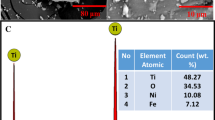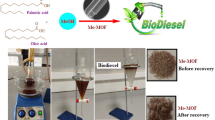Abstract
This paper describes the application of chromium(III) terephthalate (Cr-Tp) and cobalt(II) terephthalate (Co-Tp) metal organic frameworks, as heterogeneous acid catalysts to avoid the yield reduction caused by saponification during the process of biodiesel production using Calophyllum inophyllum oil. The catalysts were mainly characterized using spectroscopic (FTIR), microscopic (SEM, energy-dispersive X-ray spectroscopy) and X-ray diffractive techniques. The surface acidity and the thermal stability of the catalysts were determined using Hammett indicator and thermo-gravimetric methods, respectively. The catalysts were employed for the pre-esterification of free fatty acid content of the oil before subjecting the oil for the transesterification of its triglyceraldehyde content. The pre-esterification was performed through a couple of successive catalytic cycles under milder conditions [25°, 1 atm, and 2/1 MeOH/oil (w/w) ratio] than the conditions reported so far. The study revealed that the successful pre-esterification required these catalysts in very small amount (< 2.5% by oil weight) and occurred within very short time (2 h for the 1st cycle and 2–4 h for the 2nd cycle), reducing the acid value of C. inophyllum oil significantly (88%) from 56.91 to ~ 6.5 mg KOH g−1. The catalytic activity of these catalysts remained unchanged even after the 10th cycle of catalyst reuse. More importantly, the yield of biodiesel obtained from C. inophyllum oil in this way was significantly high (~ 93%) and free from saponification.




























Similar content being viewed by others

References
International Energy Agency, Key World Energy Statistics, 2016. https://doi.org/10.1787/key_energ_stat-2016-en
EIA, Annual Energy Outlook 2016 (Office of Integrated International Energy Analysis, 2015)
S.H. Mohr, J. Wang, G. Ellem, J. Ward, D. Giurco, Projection of world fossil fuels by country. Fuel 141, 120–135 (2015). https://doi.org/10.1016/j.fuel.2014.10.030
C. Pathak, H.C. Mandalia, Petroleum industries: environmental pollution effects, management and treatment methods. Int. J. Sep. Environ. Sci. 1, 55–62 (2012)
The Hidden Cost of Fossil Fuels (Union of Concerned Scientists, n.d.). http://www.ucsusa.org/clean_energy/our-energy-choices/coal-and-other-fossil-fuels/the-hidden-cost-of-fossil.html. Accessed 18 April 2016
E.M. Galán, T. Foley, L. Junfeng, Renewables 2015 Global Status Report (2015)
M. Balat, H. Balat, A critical review of bio-diesel as a vehicular fuel. Energy Convers. Manag. 49, 2727–2741 (2008). https://doi.org/10.1016/j.enconman.2008.03.016
Y. Zhang, M.A. Dubé, D.D. McLean, M. Kates, Biodiesel production from waste cooking oil: 2. Economic assessment and sensitivity analysis. Bioresour. Technol. 90, 229–240 (2003). https://doi.org/10.1016/s0960-8524(03)00150-0
M. Borhanipour, P. Karin, M.T. Chollacoop, N. Chollacoop, K. Hanamura, Comparison Study on Fuel Properties of Biodiesel from Jatropha, Palm and Petroleum Based Diesel Fuel (SAE International, 2014). https://doi.org/10.4271/2014-01-2017
A.E. Atabani, A.D.S. César, Calophyllum inophyllum L.—a prospective non-edible biodiesel feedstock. Study of biodiesel production, properties, fatty acid composition, blending and engine performance. Renew. Sustain. Energy Rev. 37, 644–655 (2014). https://doi.org/10.1016/j.rser.2014.05.037
R. Sawangkeaw, S. Ngamprasertsith, A review of lipid-based biomasses as feedstocks for biofuels production. Renew. Sustain. Energy Rev. 25, 97–108 (2013). https://doi.org/10.1016/j.rser.2013.04.007
Y. Zhang, Biodiesel production from waste cooking oil: 1. Process design and technological assessment. Bioresour. Technol. 89, 1–16 (2003). https://doi.org/10.1016/s0960-8524(03)00040-3
J. McMurry, Organic Chemistry, 5th edn. (Brooks/Cole, Belmont, 2000)
T.H. Lowry, K.S. Richardson, Mechanism and Theory in Organic Chemistry (1976). https://doi.org/10.1021/ed066pa131.2
M.E. Borges, L. Díaz, Recent developments on heterogeneous catalysts for biodiesel production by oil esterification and transesterification reactions: a review. Renew. Sustain. Energy Rev. 16, 2839–2849 (2012). https://doi.org/10.1016/j.rser.2012.01.071
J. Zhang, L. Jiang, Acid-catalyzed esterification of Zanthoxylum bungeanum seed oil with high free fatty acids for biodiesel production. Bioresour. Technol. 99, 8995–8998 (2008). https://doi.org/10.1016/j.biortech.2008.05.004
T.M.M. Marso, C.S. Kalpage, M.Y. Udugala-Ganehenege, Metal modified graphene oxide composite catalyst for the production of biodiesel via pre-esterification of Calophyllum inophyllum oil. Fuel 199, 47–64 (2017)
G.F. Silva, F.L. Camargo, A.L.O. Ferreira, Application of response surface methodology for optimization of biodiesel production by transesterification of soybean oil with ethanol. Fuel Process. Technol. 92, 407–413 (2011). https://doi.org/10.1016/j.fuproc.2010.10.002
Y.M. Sani, W.M.A.W. Daud, A.R. Abdul Aziz, Activity of solid acid catalysts for biodiesel production: a critical review. Appl. Catal. A 470, 140–161 (2014). https://doi.org/10.1016/j.apcata.2013.10.052
A. Casas, M.J. Ramos, J.F. Rodríguez, Á. Pérez, Tin compounds as Lewis acid catalysts for esterification and transesterification of acid vegetable oils. Fuel Process. Technol. 106, 321–325 (2013). https://doi.org/10.1016/j.fuproc.2012.08.015
S.K. Mandal, H.W. Roesky, Designing molecular catalysts with enhanced Lewis acidity. Adv. Catal. 54, 1–61 (2011). https://doi.org/10.1016/b978-0-12-387772-7.00001-0
B. Peng-Lim, S. Ganesan, G.P. Maniam, M. Khairuddean, J. Efendi, A new heterogeneous acid catalyst for esterification: optimization using response surface methodology. Energy Convers. Manag. 65, 392–396 (2013). https://doi.org/10.1016/j.enconman.2012.08.002
B. Peng-Lim, S. Ganesan, G. Pragas, M. Khairuddean, Sequential conversion of high free fatty acid oils into biodiesel using a new catalyst system. Energy 46, 132–139 (2012). https://doi.org/10.1016/j.energy.2012.09.013
H.R. Ong, M.R. Khan, M.N.K. Chowdhury, A. Yousuf, C.K. Cheng, Synthesis and characterization of CuO/C catalyst for the esterification of free fatty acid in rubber seed oil. Fuel 120, 195–201 (2014). https://doi.org/10.1016/j.fuel.2013.12.015
M. Zabeti, W.M.A. Wan Daud, M.K. Aroua, Activity of solid catalysts for biodiesel production: a review. Fuel Process. Technol. 90, 770–777 (2009). https://doi.org/10.1016/j.fuproc.2009.03.010
S. Horike, M. Dincǎ, K. Tamaki, J.R. Long, Size-selective Lewis acid catalysis in a microporous metal-organic framework with exposed Mn2+ coordination sites. J. Am. Chem. Soc. 130, 5854–5855 (2008). https://doi.org/10.1021/ja800669j
K. Schlichte, T. Kratzke, S. Kaskel, Improved synthesis, thermal stability and catalytic properties of the metal-organic framework compound Cu3(BTC)2. Microporous Mesoporous Mater. 73, 81–88 (2004). https://doi.org/10.1016/j.micromeso.2003.12.027
M. Vandichel, F. Vermoortele, S. Cottenie, D.E. De Vos, M. Waroquier, V. Van Speybroeck, Insight in the activity and diastereoselectivity of various Lewis acid catalysts for the citronellal cyclization. J. Catal. 305, 118–129 (2013). https://doi.org/10.1016/j.jcat.2013.04.017
Y.K. Hwang, D.Y. Hong, J.S. Chang, S.H. Jhung, Y.K. Seo, J. Kim, A. Vimont, M. Daturi, C. Serre, G. Férey, Amine grafting on coordinatively unsaturated metal centers of MOFs: consequences for catalysis and metal encapsulation. Angew. Chem. Int. Ed. 47, 4144–4148 (2008). https://doi.org/10.1002/anie.200705998
M. Hartmann, M. Fischer, Amino-functionalized basic catalysts with MIL-101 structure. Microporous Mesoporous Mater. 164, 38–43 (2012). https://doi.org/10.1016/j.micromeso.2012.06.044
N.V. Maksimchuk, M.N. Timofeeva, M.S. Melgunov, A.N. Shmakov, Y.A. Chesalov, D.N. Dybtsev, V.P. Fedin, O.A. Kholdeeva, Heterogeneous selective oxidation catalysts based on coordination polymer MIL-101 and transition metal-substituted polyoxometalates. J. Catal. 257, 315–323 (2008). https://doi.org/10.1016/j.jcat.2008.05.014
N.V. Maksimchuk, K.A. Kovalenko, V.P. Fedin, O.A. Kholdeeva, Heterogeneous selective oxidation of alkenes to α, β-unsaturated ketones over coordination polymer MIL-101. Adv. Synth. Catal. 352, 2943–2948 (2010). https://doi.org/10.1002/adsc.201000516
Y. Zhou, J. Song, S. Liang, S. Hu, H. Liu, T. Jiang, B. Han, Metal-organic frameworks as an acid catalyst for the synthesis of ethyl methyl carbonate via transesterification. J. Mol. Catal. A 308, 68–72 (2009). https://doi.org/10.1016/j.molcata.2009.03.027
F.G. Cirujano, A. Corma, F.X. Llabrés i Xamena, Zirconium-containing metal organic frameworks as solid acid catalysts for the esterification of free fatty acids: synthesis of biodiesel and other compounds of interest. Catal. Today 257, 213–220 (2015). https://doi.org/10.1016/j.cattod.2014.08.015
Y. Zang, J. Shi, X. Zhao, L. Kong, F. Zhang, Y. Zhong, Highly stable chromium(III) terephthalate metal organic framework (MIL-101) encapsulated 12-tungstophosphoric heteropolyacid as a water-tolerant solid catalyst for hydrolysis and esterification. React. Kinet. Mech. Catal. 109, 77–89 (2013). https://doi.org/10.1007/s11144-013-0547-4
X. Deng, Z. Fang, Y.H. Liu, C.L. Yu, Production of biodiesel from Jatropha oil catalyzed by nanosized solid basic catalyst. Energy 36, 777–784 (2011). https://doi.org/10.1016/j.energy.2010.12.043
H. Benesi, Acidity of catalyst surfaces. 1. Acid strength from colors of adsorbed indicators. J. Am. Chem. Soc. 78, 5490–5494 (1956). https://doi.org/10.1021/ja01602a008
ASTM International, ASTM D974-06 Standard Test Method for Acid and Base Number by Color-Indicator Titration (ASTM, 2006). https://doi.org/10.1520/d0974-14e01
S.R. Gadagkar, G.B. Call, Computational tools for fitting the Hill equation to dose–response curves. J. Pharmacol. Toxicol. Methods 71, 68–76 (2015). https://doi.org/10.1016/j.vascn.2014.08.006
R. Elvas-Leitão, L. Moreira, F. Martins, Design of an Excel spreadsheet to estimate rate constants, determine associated errors, and choose curve’s extent. J. Chem. Educ. 83, 1879 (2006). https://doi.org/10.1021/ed083p1879
H.L. Anderson, A. Kemmler, R. Strey, Comparison of different non-linear evaluation methods in thermal analysis. Thermochim. Acta 271, 23–29 (1996)
A.D. Ferrão-Gonzales, I.C. Véras, F.A.L. Silva, H.M. Alvarez, V.H. Moreau, Thermodynamic analysis of the kinetics reactions of the production of FAME and FAEE using Novozyme 435 as catalyst. Fuel Process. Technol. 92, 1007–1011 (2011). https://doi.org/10.1016/j.fuproc.2010.12.023
C.S. Kalpage, T.M.M.K. Ranathunga, Biodiesel; oil expelling and processing, in: Proceedings of SAARC Regional Training Workshop. BIOFUELS, 2008, p. 52. https://doi.org/10.1017/cbo9781107415324.004
R. Da Tech, Bubble Washing Biodiesel (2016). http://www.make-biodiesel.org/Water-Washing/water-washing-bio.html. Accessed 6 March 2016.
FAME Mix, C4–C24 (Sigma Aldrich, 2016). http://www.sigmaaldrich.com/catalog/product/supelco/189191amp?lang=en®ion=LK. Accessed 6 March 2016
S. Wang, L. Bromberg, H. Schreuder-Gibson, T.A. Hatton, Organophophorous ester degradation by chromium(III) terephthalate metal-organic framework (MIL-101) chelated to N, N-dimethylaminopyridine and related aminopyridines. ACS Appl. Mater. Interfaces 5, 1269–1278 (2013)
G. Férey, C. Mellot-Draznieks, C. Serre, F. Millange, J. Dutour, S. Surblé, I. Margiolaki, A chromium terephthalate-based solid with unusually large pore volumes and surface area. Science 309, 2040–2042 (2005). https://doi.org/10.1126/science.1116275
M. Kurmoo, H. Kumagai, M.A. Green, B.W. Lovett, S.J. Blundell, A. Ardavan, J. Singleton, Two modifications of layered cobaltous terephthalate: crystal structures and magnetic properties. J. Solid State Chem. 159, 343–351 (2001). https://doi.org/10.1006/jssc.2001.9163
N. Guillou, C. Livage, G. Férey, Cobalt and nickel oxide architectures in metal carboxylate frameworks: from coordination polymers to 3D inorganic skeletons. Eur. J. Inorg. Chem. (2006). https://doi.org/10.1002/ejic.200600663
S.S. Vieira, Z.M. Magriotis, N.A.V. Santos, A.A. Saczk, C.E. Hori, P.A. Arroyo, Biodiesel production by free fatty acid esterification using lanthanum (La3+) and HZSM-5 based catalysts. Bioresour. Technol. 133, 248–255 (2013). https://doi.org/10.1016/j.biortech.2013.01.107
M.E. Davis, R.J. Davis, Fundamentals of Chemical Reaction Engineering, 1st edn. (McGraw-Hill, New York, 2003)
K.A. Kovalenko, A.M. Cheplakova, P.V. Burlak, V.P. Fedin, Coordination modification and sorption properties of mesoporous chromium(III) terephthalate. Russ. J. Inorg. Chem. 60, 873–877 (2015). https://doi.org/10.1134/s0036023615070086
A.B. Ferreira, A. Lemos Cardoso, M.J. da Silva, Tin-catalyzed esterification and transesterification reactions: a review. ISRN Renew. Energy (2012). https://doi.org/10.5402/2012/142857
M. Berrios, J. Siles, M.A. Martın, A. Martın, A kinetic study of the esterification of free fatty acids (FFA) in sunflower oil. Fuel 86, 2383–2388 (2007). https://doi.org/10.1016/j.fuel.2007.02.002
S. Pasias, N. Barakos, C. Alexopoulos, N. Papayannakos, Heterogeneously catalyzed esterification of FFAs in vegetable oils. Chem. Eng. Technol. 29, 1365–1371 (2006). https://doi.org/10.1002/ceat.200600109
A.S. Yusuff, O.D. Adeniyi, S.O. Azeez, M.A. Olutoye, U.G. Akpan, Synthesis and characterization of anthill-eggshell-Ni–Co mixed oxides composite catalyst for biodiesel production from waste frying oil. Biofuels Bioprod. Biorefin. 13, 37–47 (2019). https://doi.org/10.1002/bbb.1914
Acknowledgements
The authors gratefully acknowledge the financial support provided by the National Research Council of Sri Lanka under the Research Grant number (13-15).
Author information
Authors and Affiliations
Corresponding author
Additional information
Publisher's Note
Springer Nature remains neutral with regard to jurisdictional claims in published maps and institutional affiliations.
Electronic supplementary material
Below is the link to the electronic supplementary material.
Rights and permissions
About this article
Cite this article
Marso, T.M.M., Kalpage, C.S. & Udugala-Ganehenege, M.Y. Application of Chromium and Cobalt Terephthalate Metal Organic Frameworks as Catalysts for the Production of Biodiesel from Calophyllum inophyllum Oil in High Yield Under Mild Conditions. J Inorg Organomet Polym 30, 1243–1265 (2020). https://doi.org/10.1007/s10904-019-01251-8
Received:
Accepted:
Published:
Issue Date:
DOI: https://doi.org/10.1007/s10904-019-01251-8




